|
FIRST FLAGS
OVER AUSTRALIA |
|
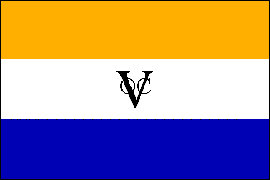
Vereenigde Oostindische Compagnie
Vlag • 1606
|
|
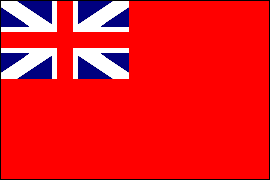 THE
RED ENSIGN
• 1707-1801 |
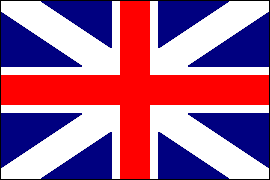 THE
UNION FLAG
• 1707-1801 |
|
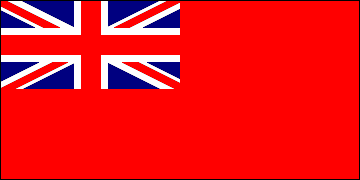
THE RED ENSIGN
• SINCE 1801 |
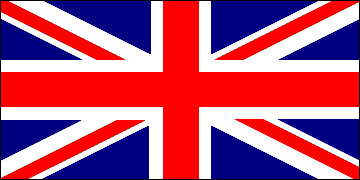
THE UNION FLAG
• SINCE 1801 |
|
The first
European flag to appear in Australian waters was the Dutch
Princevlag (Prince's Flag), a horizontal orange (later
red)-white-blue tricolor, probably including the monogram of the
Dutch East India Company (Vereenigde Oostindische Compagnie
or VOC) in black on the white stripe. The Dutch explorer
Willem Janszoon made landfall on
the coast of the continent in 1606 and he was followed in the course
of the seventeenth and early eighteenth centuries by a number of
other Dutch explorers who charted much of Australia's coastline.
There were proposals for the establishment of trading posts or
colonial settlements in "New Holland" but these were turned down by
the VOC, which saw few opportunities for profitable trade with the
primitive inhabitants of the country. The British explorer, Captain
James Cook, made landfall at Botany Bay (present-day Sydney, New
South Wales) in 1770. But only in 1788 was the first permanent
colony established, by the British at Botany Bay. Thereafter
colonization proceeded rapidly and by the mid-nineteenth century
there were a number of separate, self-governing Australian colonies.
The first British flags over
Australia were the Union Jack and its derivatives, particularly the
Red Ensign. From these were developed the first distinctively
Australian flags. |
|
EARLY COLONIAL FLAGS |
|
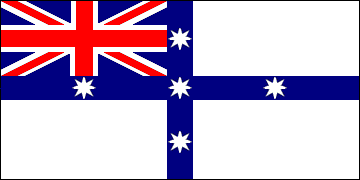
NEW SOUTH WALES ENSIGN • 1832-83 |
|
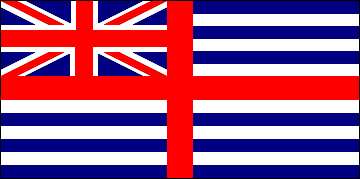
VAN DIEMEN'S LAND ENSIGN • 1850-75 |
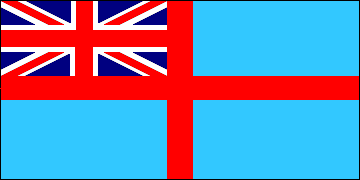
QUEENSLAND
ENSIGN
• 1859-70 |
|
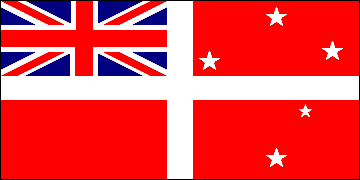
TASMANIAN COLONIAL ENSIGN • 1875 |
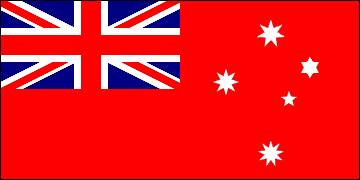
VICTORIA RED
ENSIGN • 1879-1903 |
|
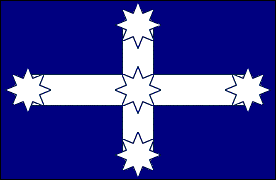
EUREKA STOCKADE FLAG |
|
A
"National Colonial Flag," essentially the British White Ensign with
four white stars on the red cross, is said to have been proposed as
a flag for Australia in the early 1820s, but its actual existence is
doubtful. Only in 1832 did there appear the first in a long line of
colonial flags incorporating distinctive Australian elements. This
was the ensign adopted by the government of New South Wales: a
British White Ensign with the cross changed from red to blue and
charged with five eight-pointed white stars representing the
Southern Cross, the most prominent constellation visible in the
night sky of the Southern Hemisphere. Sometimes called the
Australian Ensign, this flag was widely used in local waters despite
the fact that it failed to conform to the standard pattern for
colonial ensigns laid down by the British Admiralty, which held
jurisdiction over such matters. In 1883 the Admiralty prohibited its
use, claiming that it was too similar to the White Ensign of the
Royal Navy. In the course of the nineteenth century other Australian
colonies adopted ensigns, mostly without reference to the Admiralty.
Several were obviously based on the White Ensign. The 1875 Tasmanian
colonial ensign, incorporating the Southern Cross, lasted only 14
days before the colonial government, realizing that it was unlikely
to be approved in London, abolished it. The Blue and Red Ensigns of
Victoria, also popular throughout Australia for many years, became
with the addition of the six-pointed Commonwealth Star the
government and civil ensigns of the Commonwealth of Australia in
1903. Note that the stars of the Southern Cross have varying numbers
of points, symbolizing their relative brightness.
Quite different in origin was the Eureka Stockade Flag, famously
associated with the 1851-54 labor unrest in the gold fields around
Ballarat in the colony of Victoria. This blue flag with its white
cross and stars flag flew over the stockade built by striking gold
miners. On December 3, 1854, the protests culminated in a violent
clash when colonial police backed up by British Army troops stormed
the Eureka Stockade. In later years this flag has been proposed as a
replacement for the current national flag, based on the claim that
the rebellion signaled the birth of an Australian national identity.
But the Eureka Rebellion remains politically controversial, its
historical significance is disputed, and such proposals have found
no favor. The original flag has survived and its remains are on
display in the Art Gallery of Ballarat. |
TOWARD COMMONWEALTH |
|
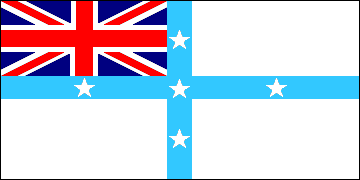
FEDERATION FLAG •
1885 |
|
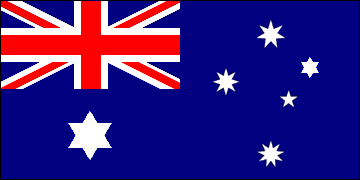
GOVERNMENT ENSIGN • 1903-09 |
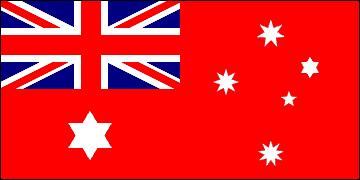
CIVIL
ENSIGN • 1903-09 |
|
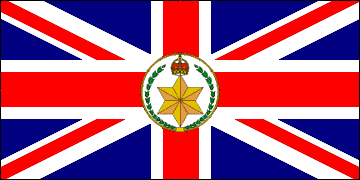
GOVERNOR-GENERAL'S FLAG • 1903-09 |
|
Toward the end of the
nineteenth century sentiment began to grow for the establishment of
a Canadian-style federation uniting the various Australian colonies,
by now six in number. The New South Wales/Australian Ensign of 1832
was revived as the Federation Flag, with five-pointed stars and a
lighter shade of blue for the cross. When the Commonwealth of
Australia was created in 1901, this flag was widely, albeit
unofficially, used as the national flag of the new polity. In 1902
Australian Prime Minister Edmund Barton submitted it as an
alternative to the winning design in the Commonwealth flag
competition (which had attracted over 15,000 entries). It was
summarily rejected in London since it did not conform to standard
British practice. However, the Federation Flag remained popular and
continued to be used for several years.
The winning
design, officially adopted in 1903, was the Victoria Blue Ensign
with a large, six-pointed Commonwealth Star, symbolizing the six
states, added beneath the Union Jack canton. A matching Red Ensign
for use by merchant vessels was adopted at the same time.
(Australian naval vessels flew the British White Ensign until 1967,
when the current ensign was adopted.) Technically the Australian
Blue Ensign was reserved for government use and Australian Red
Ensign was reserved for merchant shipping, but the latter came to be
used on land by private citizens, sometimes in conjunction with the
Union Jack and sometimes on its own. This practice continued until
the passage of the Flags Act 1953, which established the Australian
Blue Ensign as the national flag.
As the British
monarch's representative, the Governor-General of the Commonwealth
of Australia flew a Union Jack defaced with a badge consisting of
the Commonwealth Star surmounted by a crown within a laurel wreath,
the whole on a white field with a narrow gold border. (in 1909 the
star became seven pointed—see below.) |
THE AUSTRALIAN FLAG
TODAY |
|
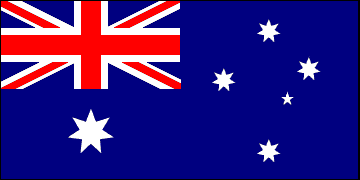
NATIONAL FLAG |
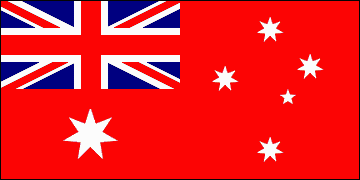
CIVIL ENSIGN |
|
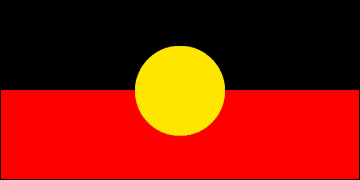
ABORIGINAL FLAG |
|
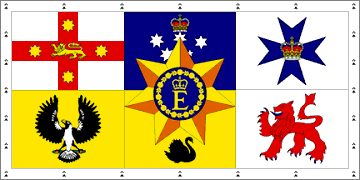
H.M. THE QUEEN'S PERSONAL FLAG |
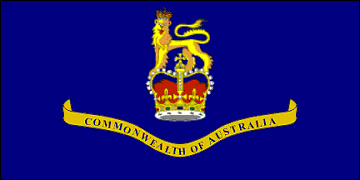
GOVERNOR-GENERAL'S FLAG |
|
In
1909 the Australian Blue and Red Ensigns were modified. The
Commonwealth Star acquired a seventh point, symbolizing the various
territories of Australia, and the four large stars of the Southern
Cross were all made seven pointed. The Governor-General's flag was
also modified to give the Commonwealth Star seven points. The
ensigns, thus modified, have remained unchanged up to the present
day. The Governor-General's flag was replaced in 1936 when a
standardized design for that office was introduced: blue with the
Royal Crest over a scroll bearing the name of the country. In 1962 a
flag was introduced for Elizabeth II's use in her capacity as Queen
of Australia. Within an ermine border it displays the arms of the
six Australian states and a Commonwealth Star charged with her
crowned initial. This flag is only used when the Queen is present on
Australian soil or on board an Australian ship. No other members of
the Royal Family have a constitutional position in Australia; thus
there are no flags for them.
The Flags Act 1953 made the Australian Blue Ensign the national flag
of the Commonwealth of Australia and since that time a number of
other flags have been designated as official flags of Australia
under the Act. Prominent among them is the Aboriginal Flag:
horizontal stripes of black and red charged with a golden yellow
disk. This flag was designed by the Aboriginal artist Harold Thomas
in 1971. Black represents the Aboriginal people of Australia, red
represents the red earth and yellow represents the Sun. The flag's
designation as an official flag of Australia in 1995 caused some
controversy. Critics charged that it was a divisive gesture while on
the other hand Thomas himself said that his flag, which had come to
be embraced by Aboriginal Australians, required no official
recognition. Despite these objections the designation went forward
and was reconfirmed in 2008. The colors of the Aboriginal Flag, or
the flag itself, figure in many of the proposals for a new
Australian national flag that have been offered over the years
(see below). |
SOME PROPOSALS FOR A NEW
AUSTRALIAN FLAG |
|
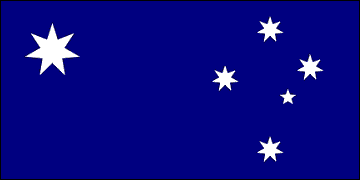
1956 REPUBLICAN SOCIALIST LEAGUE PROPOSAL |
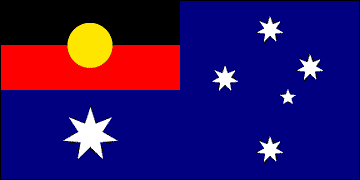
ABORIGINAL COMBINATION PROPOSAL |
|
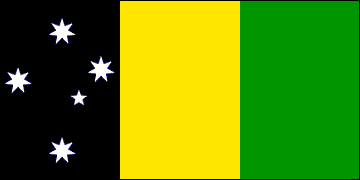
1993
A CURRENT AFFAIR CONTEST WINNER
DESIGNED BY DAVID COUZENS |
|
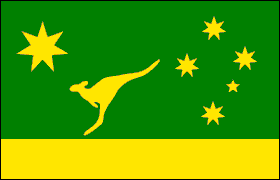
1999 DESIGN BY PETER MARWICK
|
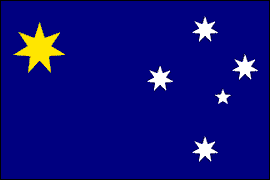
2000 AUSFLAG PROFESSIONAL DESIGN COMPETITION
WINNING DESIGN BY FRANCK GENTIL |
|
In the years following
World War II the evolution of a specifically Australian national
consciousness, independent of the British connection, became a
factor in culture and politics. This was reflected in a growing
movement for the adoption of a new national flag. Advocates for a
new flag argued that the Australian Blue Ensign with its Union Jack
canton was a reminder of the colonial past and did not properly
symbolize the modern nation. One of the earliest proposals for a new
flag was that of the Republican Socialist League of Australia: the
deletion of the Union Jack and its replacement with the Commonwealth
Star. Another proposal, dating from the 1980s, was to replace the
Union Jack with the Aboriginal Flag. This design became popular with
groups advocating the abolition of the monarchy and the creation of
an Australian republic.
Perhaps inevitably, the
push for a new flag became entangled with other contentious
political issues. There has always been considerable overlap between
those calling for a new Australian flag and those calling for an
Australian republic; on the other hand, monarchists tend to favor
the retention of the current flag. In 1999 the question of a
republic was put to Australians in a national referendum. It was
widely expected that the republican side would prevail and that this
would lead to the adoption of a new flag for the Republic of
Australia. But to the surprise of many, Australians voted to retain
the monarchy—a setback also for proponents of a new flag. The push
for a new flag was renewed in 2000 when Australia hosted the Olympic
Games and again in 2001 when the country celebrated the centenary of
the Commonwealth. But while support for the existing flag was
strong, there was no general agreement on the other side about a
replacement design. This remains the situation today and it appears
unlikely that Australia will adopt a new national flag any time
soon.
Over the years there have
been scores of Australian flag proposals, some surpassingly ugly but
others quite attractive. Many are based on the Australian national
colors, green and gold. One interesting proposal is David Couzens'
1993 design, a vertical tricolor combining green and gold with black
from the Aboriginal Flag and retaining the Southern Cross. Many
proposals, such as Peter Marwick's 1999 design, incorporate that
most familiar Australian symbol, the kangaroo. See
here for some additional Australian
flag proposals. |
























